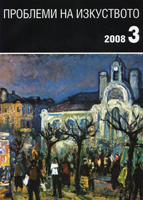„Паметници на църковното изкуство ХІV-ХІХ век“ в Националния археологически музей
‘Monuments of Religious Art from the 14th-19th Centuries’ at the National Archaeological Museum
Author(s): Tsveta ValevaSubject(s): Cultural history
Published by: Институт за изследване на изкуствата, Българска академия на науките
Summary/Abstract: The exhibit Monuments of Religious Art from the 14th-19th Centuries at the National Archaeological Museum (NAM) stands out as one of the key events marking the International Day of Museums in Sofia, yet it undoubtedly goes beyond the boundaries and goals of that celebration. It is an initiative by the NAIM and the Institute of Art Studies at BAS. The exhibition includes more than 80 artworks from the period from the 14th-19th centuries: icons, fragments of wall paintings, prints and engravings on metal and wood, works in metal and mother-of-pearl, and wood-carvings. All of them are being shown for the first time. The exhibit presents valuable information and traces directions in specialists’ research, while the small catalog (written by Ivanka Gergova) published to accompany the exhibit constitutes an important academic contribution to the popularization of these artworks and the attributions of some of them. Furthermore, the exhibit gives an idea of the state of the collection of artifacts of Orthodox religious art held in the Archaeological Museum’s Medieval Collection, which was inherited from the National Museum. The majority of the works in the exhibition are post-Byzantine and Revival Period works; however, despite their smaller number, the emphasis is on works from the 14th century. They include the Epitaphios icon, a fragment of the scene of Lazarus’s Resurrection from the St. Marina stone church near Karlukovo and to metal molds for the casing of Evangeliaria. Another highlight of the exhibition is the icon St. Dimitar on a Throne (late 15th century), which is representative of one of the leading tendencies in the Balkans during that period. The most interesting works from the 16th-17th centuries include a bronze fragment of horos from the Church of the Virgin Mary Peribleptos in Ohrid (1549) and a crucifix from the iconostasis of the St. John the Theologian Church in Poganovski Monastery (1620), among others. The most widely represented period is the Revival Era, represented by a selection of works by Greek (Mount Athos), Russian, Romanian, Polish and, of course, Bulgarian masters from prominent artistic centers. They include the Mount Athos engraver Brother Parteniy and the icon painter Apostol Longianos Vodeniotis, a Bulgarian born in Voden, Greece. Works by the Samokov masters – icon painters and engravers – bear witness to the development of the Samokov Artistic School of the 18th-19th centuries. Two of the artifacts can be attributed to the founder of the school, Hristo Dimitrov, while two others of the work of Zahari Zograf. Of particular significance is the icon The Virgin of Kikos (1829), since it is the earliest work signed by Zahari Zograf.
Journal: Проблеми на изкуството
- Issue Year: 2008
- Issue No: 3
- Page Range: 43-45
- Page Count: 3
- Content File-PDF

